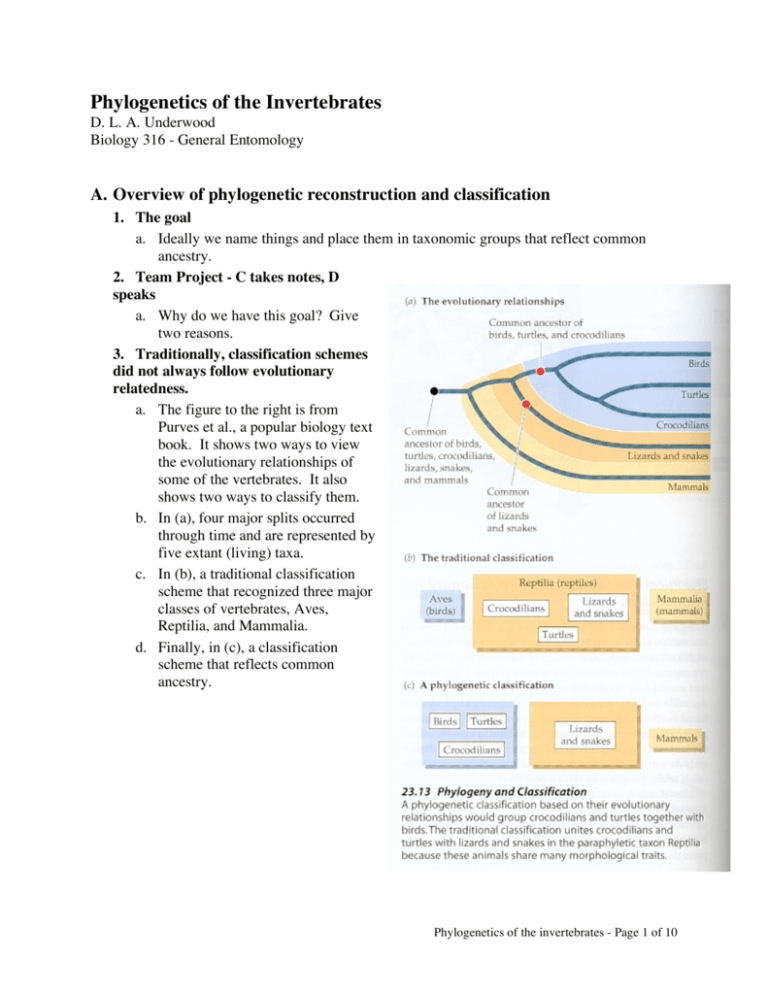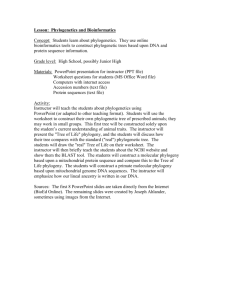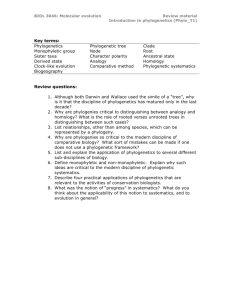Phylogenetics of the Invertebrates
advertisement

Phylogenetics of the Invertebrates D. L. A. Underwood Biology 316 - General Entomology A. Overview of phylogenetic reconstruction and classification 1. The goal a. Ideally we name things and place them in taxonomic groups that reflect common ancestry. 2. Team Project - C takes notes, D speaks a. Why do we have this goal? Give two reasons. 3. Traditionally, classification schemes did not always follow evolutionary relatedness. a. The figure to the right is from Purves et al., a popular biology text book. It shows two ways to view the evolutionary relationships of some of the vertebrates. It also shows two ways to classify them. b. In (a), four major splits occurred through time and are represented by five extant (living) taxa. c. In (b), a traditional classification scheme that recognized three major classes of vertebrates, Aves, Reptilia, and Mammalia. d. Finally, in (c), a classification scheme that reflects common ancestry. Phylogenetics of the invertebrates - Page 1 of 10 4. Team project - B takes notes, A speaks a. Describe two ways that a classification scheme influences your thinking about the evolutionary history of the organisms in question. You may contrast the “traditional” and the “phylogenetic” classifications depicted in the previous figure. B. Terminology and how to read a cladogram or phylogenetic tree 1. An example using the familiar vertebrates (taken from Hickman et al. 1995) a. In the cladogram below, a nested hierarchy of taxa is depicted. b. Amphioxus is the outgroup, and the study group comprises four vertebrates (bass, lizard, horse, and monkey). c. Four characters that vary among the vertebrates are used to generate a simple cladogram: presence versus absences of four legs, amniotic eggs, hair, and mammary glands. d. For the four characters, absence is the ancestral state in vertebrates because this is the condition found in the outgroup, Amphioxus. e. For each character, presence is the derived state in vertebrates. f. Because they share presence of four legs and amniotic eggs as synapomorphies, the lizard, horse, and monkey form a clade relative to the bass. These characters are also called shared, derived traits. g. This clade is subdivided further by two synapomorphies (presence of hair and mammary glands) that unite the horse and monkey relative to the lizard. h. We know from comparisons involving even more distantly related animals that presence of vertebrae and jaws constitute synapomorphies of the vertebrates and that Amphioxus, which lacks these features, falls outside the vertebrate clade. i. The horse and monkey are sister taxa. The horse-monkey clade and lizards are sister taxa. Phylogenetics of the invertebrates - Page 2 of 10 C. Tools used in phylogenetic reconstruction 1. Types of traits a. Morphological, physiological, behavioral i Traits expressed during development ii In juvenile forms iii In adult forms b. Molecular data i Amino acid substitutions in proteins ii Genomic genes and gene products iii Mitochondrial genes 2. Evolution as descent with modification a. Ancestral traits i Organisms that share a common ancestor retain some of the traits of that ancestor. ii These traits are only useful in determining membership into a potential phylogenetic tree. For example, the presence of four limbs unites the tetrapods, but doesn't tell us anything as the sequence of their evolutionary divergence. b. Derived traits i If a trait changes from the ancestral trait, it is derived. For example, snakes have lost their four limbs. Loss of limbs is the derived state. ii If organisms exhibit the same change in an ancestral trait, it is termed a shared derived trait (synapomorphy). c. Homologous traits i Traits that are derived from the same ancestral trait. ii For morphological traits, the structure is derived from the same embryological tissue. d. Homoplastic traits (analogous traits) i Traits may resemble one another not due to common ancestry, but due to other evolutionary processes. ii Convergent evolution results in traits arising independently. The same selective forces that drove the evolution of the trait in one group of organisms can drive the evolution of a similar looking trait in an unrelated group of organisms. For example, loss of limbs has evolved numerous times in both reptiles and amphibians. iii Evolutionary reversals occur when a character changes from a derived state back to the ancestral state. Seastar adults have radial symmetry, yet they are placed within the clade of animals whose shared derived trait is bilateral symmetry. The larval forms of seastars are bilaterally symmetrical. 3. Team project - D takes notes, C speaks a. Give two attributes of traits that tend to homoplastic. In other words, what about certain traits that make them more susceptible to convergent evolution or reversals? Phylogenetics of the invertebrates - Page 3 of 10 4. Data processing a. Parsimony is usually employed. This idea merely reflects our feeling that changes through time do not occur that frequently and a phylogenetic tree should have the fewest changes. For example, in the phylogeny above, jaws evolved only once, rather than each major vertebrate class independently evolving jaws. We will explore this in lab. b. Molecular data require the use of computer programs that calculate the probability of a given set of mutations occurring. Nucleotide substitutions are common and not all substitutions are equally likely. The most common method is called maximum likelihood. c. Ideally, a researcher will use both morphological and molecular data in constructing a phylogeny. d. Computer programs generate numerous possible phylogenies (sometimes hundreds, depending upon the data set). All of these trees are compared and a consensus tree is constructed that reflects only those lineage splits that are found in the majority of the most parsimonious trees. D. When classification does not reflect phylogeny 1. There are many ways to lump organisms into categories. a. "Reptiles" may include birds as well as snakes, lizards, crocodiles, and turtles, or it may not. b. A monophyletic taxon includes all of the descendents of a single common ancestor. This is the ideal classification. c. A paraphyletic taxon includes a single common ancestor but not all of the descendents. Excluding birds from the Class Reptilia renders it a paraphyletic grouping. Many of our names and groupings of creatures were originally coined long before the advent of reconstructing phylogenies. Even though we all know that birds are reptiles, albeit highly derived, most people do not include them when discussing reptiles. Intellectual inertia is an extremely difficult force from which to break! d. A polyphyletic grouping contains members who share more than one most recent common ancestor. These groupings are generally the result of insufficient data. Phylogenetics of the invertebrates - Page 4 of 10 E. Where does the Phylum Arthropoda fit within the Kingdom Animalia? 1. Classification before the use of molecular data was based strictly on morphology, primarily types of body cavities, larval forms, segmentation, etc. a. The bilaterally symmetrical animals were divided into two major clades, the protostomes and the deuterostomes. (See cladogram on penultimate page.) b. Current thoughts retain the protostome and deuterostome clades, but a major reorganization of the protostomes has occurred. c. Protostomes are now divided into two clades, the Lophotrochozoa and the Ecdysozoa, based on ecdysis (growth by molting) and cleavage pattern. Phylogenetics of the invertebrates - Page 5 of 10 F. The Ecdysozoa a. Note that the Arthropoda is depicted as have four subphyla, not the five that we covered in lecture previously. Folks who study these groups no longer recognize the Uniramia. Even though the five subphyla have been agreed upon in the primary literature, it will take some time before this is reflected in textbooks (again, intellectual inertia!). b. The placement of the Onychophora and the Tardigrada are also depicted above as being sister taxa. This is no longer a well-supported hypothesis. G. Two "minor" phyla of interest 1. The two phyla below are considered to be the sister taxa to the Phylum Arthropoda. a. A sister taxon is the most closely related taxon to the group in question. b. All three phyla share the ability to grow by molting (ecdysis). 2. Phylum Onychophora (velvet worms) a. The velvet worms comprise 70 species of caterpillar-like animals that live in moist warm environments. Phylogenetics of the invertebrates - Page 6 of 10 b. They have an over 500-million-year history - some of the coolest fossils found in the Burgess Shale, located in Yoho National Park, in the Rocky Mountains, near Field, British Columbia, Canada, are onychophorans. c. Characteristics shared with the arthropods include a chitinous cuticle, an open circulatory system with hemocoel, and a tracheal system. d. Recent ribosomal RNA sequence data suggest that they are indeed arthropods. 3. Phylum Tardigrada (water bears) a. The water bears are minute, usually less than a millimeter in length. b. There are 300-400 species living in water film surrounding mosses and lichens; some are freshwater and a few are marine. c. The tardigrades show segmentation, "malpighian tubules", arthropod-like musculature and setae. 4. The placement of these two phyla differs depending upon the researcher. a. Biology textbooks place them as sister taxa to one another with the tardigradeonychorphora clade a sister to the arthropods (as was seen in the Ecdysozoa tree above). b. Others place either one of them as the sister taxon to the arthropods. c. Here is one possible phylogeny. H. A phylogenetic view of the Phylum Arthropoda 1. On the last page of the outlines you will find a traditional phylogeny for the arthropod subphyla and the major classes based on morphology. a. I include it here as an example of how our interpretation has been dramatically altered with Articulating, jointed the relatively appendages recent addition of Setae molecular Malpighian tubules data. b. This view is Growth by ecdysis represented Appendages in tree (A) Hemocoel and open circulatory system below. Loss of ectodermal cilia Phylogenetics of the invertebrates - Page 7 of 10 2. Below are four different hypotheses combining both morphological and molecular data. a. Tree (C) currently garners the strongest support. Phylogenetics of the invertebrates - Page 8 of 10 One Possible Metazoan Phylogeny A traditional phylogeny of the Kingdom Animalia Cnidaria Platyhelminthes Arthropoda 13 Annelida 16 15 12 Mollusca 19 18 17 14 Echinodermata 23 22 Chordata 25 26 24 11 5 10 4 9 21 8 3 20 7 6 1 2 1- multicellularity 2- collagen 3- radial symmetry 4- cnidae 5- planula larva 6- bilateral symmetry 7- triploblastic 8- spiral cleavage 9- mesoderm arises from the 4d cell 10- complete gut with mouth arising from the blastopore 11- coelom by schizocoely 12- compound eyes 13- articulated appendages with chitinous exoskeleton 14- trochophore larvae 15- head of prostomium and peristomium 16- serially arranged body setae 17- coelom reduced; body cavity a hemocoel 18- radula 19- mantle which secretes a shell 20- coelom arises by enterocoely 21- blastopore becomes the anus 22- water vascular system 23- secondarily pentaradial symmetry 24- dorsal hollow nerve cord 25- notochord 26- pharyngeal gill slits Phylogenetics of the invertebrates - Page 9 of 10 A traditional phylogeny of the Arthropoda Subphyla Crustacea 10 7 9 a 14 26 25 22 16 Ins ect a 24 23 15 po d op Ch ilo Me 17 Di pl hn Ar ac 18 8 od a Uniramia ros tom Ma ata lac ost rac Ma a xil lip od a Br anc hio po Ce da ph alo car Re id mi ped a ia Chelicerata ida Trilobitomorpha 21 20 6 13 12 5 4 19 3 11 Phylum Arthropoda 2 1 1- articulated appendages with chitinous exoskeleton 2- compound eyes 3- body divided into prosoma and opisthosoma, without distinct head 4- first appendages chelicerae 5- second appendages pedipalps 6- typically with four pairs of walking legs 7- opisthosomal appendages reduced, lost, or modified as spinnerets or pectines 8- with trachae, book lungs, or both 9- opisthosomal appendages modified as book gills 10- telson long and spiked 11- mandibles present 12- biramous anntenules and antennae 13- nauplius larvae 14- fully developed carapace 15- maxillae reduced or absent 16- thorax shortened to fewer than 11 segments 17- thorax shortened to fewer than 6 segments 18- male gonopores fixed on thoracomere 19- tracheal gas exchange system 20- malpighian tubules 21-one pair of antennae 22- loss of compound eyes 23- two pair of walking legs per somite 24- one pair of walking legs per somite 25- loss of abdominal appendages 26- formation of distinct three-segmented body head, thorax and abdomen Phylogenetics of the invertebrates - Page 10 of 10








